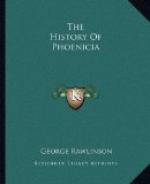On another cylinder, which is certainly Phoenician, a rude representation of a sacred tree occupies the central position. To the left stands a worshipper with the right hand upraised, clad in a very common Assyrian dress. Over the sacred tree is a coarse specimen of the winged circle or disk, with head and tail, and fluttering ends of ribbon.[794] On either side stand two winged genii, dressed in long robes, and tall stiff caps, such as are often seen on the heads of Persians in the Persepolitan sculptures, and on the darics.[795] In the field is a Phoenician inscription, which is read as {...} or Irphael ben Hor’adad, “Irphael, the son of Horadad."[796]
Phoenician cylinders are in glass, green serpentine, cornaline, black haematite, steatite, and green jasper.[797] They are scratched rather than deeply cut, and cannot be said ever to attain to any considerable artistic beauty. Those which have been here given are among the best; and they certainly fall short, both in design and workmanship, of many Assyrian, Babylonian, and even Persian specimens.
The gems, on the other hand, are in many cases quite equal to the Assyrian. There is one of special merit, which has been pronounced “an exquisite specimen of Phoenician lapidary art,"[798] figured by General Di Cesnola in his “Cyprus."[799] Two men in regular Assyrian costume, standing on either side of a “Sacred Tree,” grasp, each of them, a branch of it. Above is a winged circle, with the wings curved so as to suit the shape of the gem. Below is an ornament, which is six times repeated, like the blossom of a flower; and below this is a trelliswork. The whole is cut deeply and sharply. Its Phoenician authorship is assured by its being an almost exact repetition of a group upon the silver patera found at Amathus.[7100]
Of other gems equally well engraved the following are specimens. No. 1 is a scarab of cornaline found by M. de Voguee in Phoenicia Proper.[7101] Two male figures in Assyrian costume face each other, their advanced feet crossing. Both hold in one hand the ankh or symbol of life. One has in the left hand what is thought to be a lotus blossom. The other has the right hand raised in the usual attitude of adoration. Between the figures, wherever there was space for them, are Phoenician characters, which are read as {...}, or l’Beka—i.e. “(the seal) of Beka."[7102] No. 2, which has been set in a ring, is one of the many scarabs brought by General Di Cesnola from Cyprus.[7103] It contains the figure of a hind, suckling her fawn, and is very delicately carved. The hind, however, is in an impossible attitude, the forelegs being thrown forwards, probably in order to prevent them from interfering with the figure of the fawn. Above the hind is an inscription, which appears to be in the Cyprian character, and which gives (probably) the name of the owner. No. 3 introduces us to domestic life. A grand lady, of Tyre perhaps or Sidon,[7104] by name




